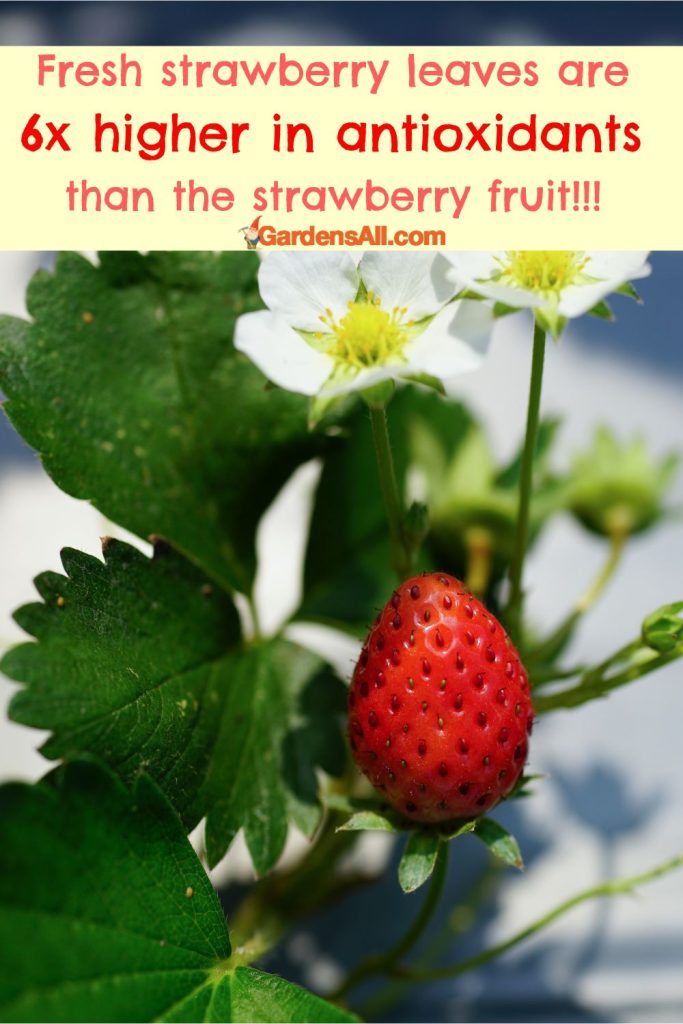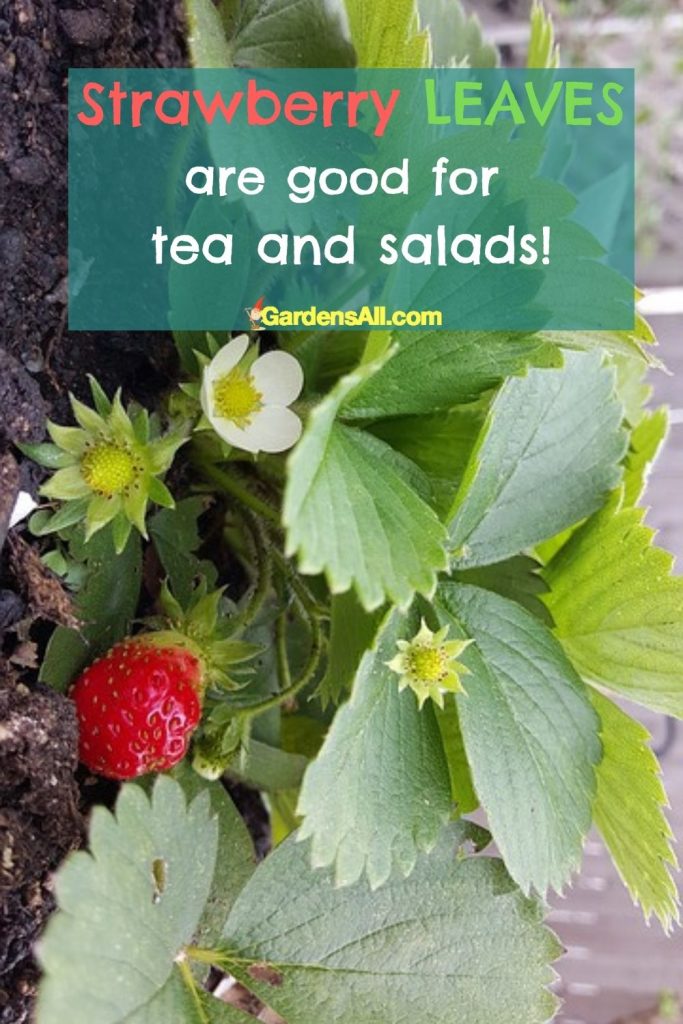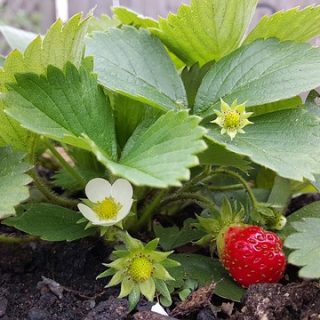Everyone is familiar with the delicious strawberry fruit, Fragaria × ananassa, as a refreshing healthy snack. The delectable berries are a favorite fruit that first ripens in late spring to herald in the delights of summer. But what about strawberry leaves benefits and uses?
After our strawberry plants stopped producing fruit, seeing all the healthy strawberry leaves in our garden, I had to ask: Is it okay to eat strawberry leaves? And if so, what are the strawberry leaves benefits and uses?
Common Questions on Strawberry Leaves Benefits and Uses
Are Strawberry Leaves Edible?
If you’re wondering if it is okay to eat strawberry leaves, the answer is yes! Not only is the strawberry leaf edible, uses and benefits include tinctures and strawberry leaf tea with nutritive and medicinal value.
Strawberries and strawberry leaves provide substantial nutrients while also fortifying your system with powerful antioxidants. You could say that strawberries and strawberry leaves are the builders and the clean-up crew. 👷🏼♀️👷🏻♂️
The nutrients help build health and the antioxidants help to clear and clean free radicals that help prevent (and possibly even eliminate) a number of diseases.
Are Strawberry Leaves and Stems Edible?
Yes! You can eat strawberry leaves, flowers, fruit and even the green tops (or bottom, depending on your perspective). That green leafy part of the strawberry stem is called calyx that surrounds the stem at the top of the strawberry.
That’s considered the “top” because of how the strawberries dangle from the stem. However, if your strawberries are sitting on your cutting board, that part is often the bottom! 😊🍓
The top green portions of strawberries are not only edible, but that calyx and strawberry leaves benefits rival that of the wonderful strawberry fruit. So, yes! It is okay to eat the green tops of strawberries, so you no longer need to cut off the strawberry tops.
In fact, a favorite way to use them is for flavored water. Just add the tops with fruit and greens attached to your water bottle and you’ve made some of your own flavor infused vitamin water!
But if the thought of eating the raw greens with the fruit isn’t appealing, there are other ways to enjoy them. But first…
Are Strawberry Leaves Poisonous…
…to Humans?
Strawberry leaves are not poisonous, but naturally, if you’re allergic to strawberries, it’s probably best to avoid consuming strawberry leaves as well.
Are Strawberry Leaves Poisonous to Dogs?
While strawberry leaves are not known to be poisonous to dogs in the amounts they might consume, it can create an upset stomach or other digestive issues for them. However, strawberries in moderation, are good for dogs and help to clean and strengthen their teeth.
~SOURCE: Chewies
You can find more on plants poisonous to dogs here.
DISCLAIMER: We’re Sharing Research and Anecdotal Uses, NOT Medical or Health Advice
All research begins with a question, and that’s what started our own deep dive researching the amazing benefits of strawberry leaves for health and wellness. We are sharing what we’ve learned from our own autodidactic study and personal use, in the hopes this may inspire you in your own discovery and expanded use of this amazing plant.
Strawberry Leaves for Health and Wellness
Strawberry plants have lots of vibrant, deep green leaves that are edible, medicinal and nutritious and can be used in a number of ways. We get into this a little later, but first let’s answer some common questions on this topic of strawberry leaves benefits and uses.
How to Use Strawberry Leaves
- Raw –
- in salads with other leafy greens
- on sandwiches like lettuce
- water and tea
- Cooked –
- in soup
- stir fry
- best blended with other leafy greens if:
- steamed
- sauteed
- Dried for –
- tea
- powder
- Extract or Tincture as a health tonic
Consider that every time you throw out strawberry tops, you’re tossing out vitamins. So instead, nibble them, toss into salads, soups, omelettes, or blend into smoothies to enrich the nutrient mix. You can also dry them for herbal tea blends and greens powders.
Harvesting and Dehydrating Strawberry Leaves for Tea
We’ve used these handy garden harvest colander baskets for years now, and we’re here’s our best food dehydrator info.
Dried strawberry leaves makes delicious and nutritious tea.

Strawberry Leaves Nutrients
Nutrients Present in Strawberry Leaves
- Vitamin C
- Vitamin K
- Iron
- Tannins (astringent)
- Flavonoids
- Proanthocyanidins
- Fragarin (antibiotic)[1]https://www.researchgate.net/publication/11904327_Effect_of_Fragarin_on_the_Cytoplasmic_Membrane_of_the_Phytopathogen_Clavibacter_michiganensis
- Polyphenols
Strawberry leaves contain many bioactive compounds including tannis, flavonoids, ascorbic acid and essential oil.

Strawberry Leaves Health Benefits
Studies show that strawberry leaves are anti-inflammatory and may reduce, improve and even eliminate diseases and symptoms such as:
- Blood pressure, (lowers blood pressure)[2]https://www.ncbi.nlm.nih.gov/pmc/articles/PMC4459800/#b27
- Blood sugar / blood glucose – strawberry leaf extract decreased blood glucose level and increased insulin levels[3]https://www.ncbi.nlm.nih.gov/pmc/articles/PMC4459800/
- Diabetes; Diabetic nephropathy (diabetically induced liver disease)[4]https://www.ncbi.nlm.nih.gov/pmc/articles/PMC4459800/[5]https://www.ncbi.nlm.nih.gov/pmc/articles/PMC4459800/#b11
- Gastrointestinal disorders[6]https://www.ncbi.nlm.nih.gov/pmc/articles/PMC4459800/#b27
- Hypercholesterolaemia, (lowers high cholesterol)[7]https://www.ncbi.nlm.nih.gov/pmc/articles/PMC4459800/#b27
- Kidney (renal dysfunction)[8]https://www.ncbi.nlm.nih.gov/pmc/articles/PMC4459800/[9]https://www.ncbi.nlm.nih.gov/pmc/articles/PMC4459800/#b11
Traditional Uses of Strawberry Leaves Cited in Folk Remedies
The Alpine or wild Strawberry, Fragaria vesca, were used in folk remedies. The roots, leaves, and fruits were used as a digestive aid, gout relief, and as a skin tonic.
The berries were used for diarrhea, and rubbed on the skin to ease the pain of sunburn and blemishes. Strawberry juice was used to brighten discolored teeth.
Ancient Romans believed the entire strawberry plant to be beneficial. They used it for inflammation, fever, throat discomfort, kidney stones, gout, fainting spells, and diseases of the blood, liver, and spleen.
- Anaemia
- Arthritis
- Digestive aid
- Diuretic
- Eyesight
- Hepatitis
- Improves –
- intestinal health
- liver activity
- metabolism
- suppresses diarrhoea
- Kidney stones – helps to expel
- Nervous system – strengthener
- Skin tonic
- Strengthens –
- immune system
- nervous system
Antioxidant Profile of Strawberry Leaves
Strawberry Leaves Are High in Antioxidants Beneficial to Health and Wellness
- Antioxidants – derived primarily from natural substances such as fruits and vegetables that may prevent or delay some types of cell damage and reduce the risk of diseases such as: [10]https://pubs.acs.org/doi/10.1021/jf9908345#
- cancer
- cardiovascular diseases
- diabetes[11]https://www.ncbi.nlm.nih.gov/pmc/articles/PMC4459800/
- Alzheimer’s disease
- Parkinson’s disease
- eye diseases such as:
- cataracts
- age related macular degeneration
NOTE: Research reveals that manmade antioxidants may not have the same benefits and may even have an adverse effects.[12]https://www.nccih.nih.gov/health/antioxidants-in-depth
- Polyphenols – strawberry leaf polyphenols are plant compounds that are packed with health benefits such as possible improvements in:[13]https://www.ncbi.nlm.nih.gov/pmc/articles/PMC6930459/
- digestion
- brain health
- heart disease
- type 2 diabetes
- certain cancers
- Chlorogenic acid properties include[14]https://www.ncbi.nlm.nih.gov/pmc/articles/PMC6155416/[15]https://pubs.acs.org/doi/10.1021/jf405589f – antioxidant
- anti-inflammatory
- anti-obesity
- anti dyslipidemia
- antidiabetic
- antihypertensive
- antimicrobial, especially as a food additive
- prebiotic benefits
- Ellagitannins[16]https://www.sciencedirect.com/science/article/abs/pii/S0963996911002572 – polyphenols present in some fruits, nuts and seeds and may be protective against some chronic diseases[17]https://www.intechopen.com/chapters/67219:
- anticancer
- anti-inflammatory
- antioxidant
- cardioprotective properties
- prebiotic
Strawberry Leaves Are Equal to or Greater Than Strawberries in Health Benefits
Studies of strawberry leaves revealed a high antioxidant capacity (oxygen radical absorbance capacity, ORAC) and total phenolic content, especially in the younger, fresher leaves.
Surprisingly, strawberry leaves were found to have much higher ORAC values than strawberry fruits.
Fresh strawberries leaves rate a much higher antioxidant capacity than strawberry fruit at an average antioxidant value of 21 for strawberries and 126 for the strawberry leaves.[18]https://pubs.acs.org/doi/10.1021/jf9908345#
“Strawberry leaves contain high amounts of diverse phenolic compounds potentially possessing defensive activities against microbial pathogens and beneficial properties for human health.”
SOURCE: April 2014 Article in article in the Journal of Agricultural and Food Chemistry [19]https://pubs.acs.org/doi/full/10.1021/jf405589f
Fresh strawberries leaves are 6x higher in antioxidant capacity than strawberry fruit.
REFERENCE: Journal of Agricultural and Food Chemistry, 2000 48 (2), 140-146, DOI: 10.1021/jf9908345
[20]https://doi.org/10.1021/jf9908345

Antioxidant Capacity of Strawberries and Strawberry Leaves – (known as ORAC values)
- 7.8 to 33.7 μmol of fresh strawberries
- 69.7 to 182.2 μmol of TE/g of fresh strawberry leaves
NOTE: μmol = micromoles; (TE/g) = Trolox equivalents in grams
A Snippet On Berries Richest in Antioxidants – listed in order of highest to lowest ORAC values
Fresh Berries
- Jewel black raspberry
- blackberries may be the richest source for antioxidants
Dried Berries
- strawberries
- black raspberries (cv. Jewel),
- blackberries
- red raspberries
Between traditional folklore use and modern research, it’s safe to conclude that strawberries and strawberry leaves benefits are well worth incorporating into your diet of antioxidant-rich foods and teas.
So if you’re growing strawberries, but have never yet made use of the strawberry leaves, we hope you’ll give it a try when yours are vibrant and green. Let us know how you’re using your strawberry leaves.
Strawberry plants put out lots of vibrant green leaves to put to use for health.

I’m LeAura Alderson, a garden, herb and plant enthusiast with a passion for discovering the many edible and medicinal benefits of the plants all around us, including the weeds! I’m a writer, editor and media publisher for our family of websites.
While I was certified in fitness and life coaching, I am NOT a health practitioner. However, I’m a lifelong health enthusiast, with a keen interest in healthy, organic foods and making home remedies and the content we share is from our own experience and usage as well as that extracted from scientific research so that you can explore further on your own.
Always seek the advice and guidance of your health practitioners first and foremost.
As a family we’re steadily expanding our gardening, experimentation and knowledge around all things gardening, edible landscaping, fresh organic foods and self sustainability with farming in our future. I also own and manage iCreateDaily.com, a site all about transformation through creation, and the power of positivity, optimism and mindset.
References

